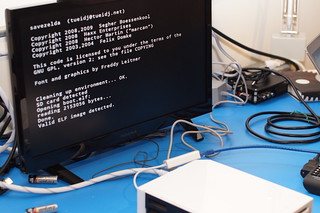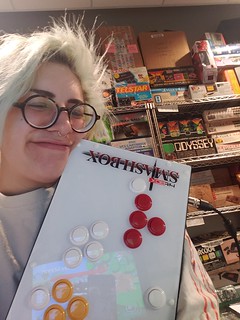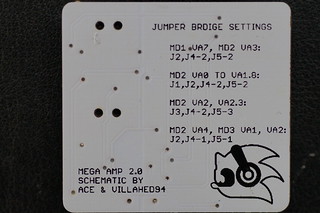Weeknotes: 22 March 2019
This was a very busy week at the Depot. We have four projects on the go: a database for the Residual Media Depot and the Media Archaeology Lab (MAL), our sister lab at University of Colorado Boulder; the Wii-modding project that we have been running for half a year; a new project dealing with Sega Genesis audio mods; and a Super Smash Brothers Melee (SSBM) project.
Database
The Depot has a lot of stuff in it. We have the largest university collection of boxed video game consoles in Canada, and the largest university collection of modified video game consoles and related signal-processing equipment in the world. And we need a better way to tell people about it.
We are in the process of expanding our current box list of holdings into a comprehensive database that will also connect to the MAL’s holdings. This is a big project, and only in its initial stages.
Our metadata structure will look a lot like the one in use at the MAL at the moment; something like this:
Accession #: (a general number for internal Depot use)
Location: (RMD of MAL)
Set: (if part of a larger collection, as most of our things are)
Medium: (hardware)
Type: (console, cable, video processor, controller, etc.)
Product Name: (full brand name)
Manufacturer: (company)
Model: (precise model and version or build number)
Year:
Original Price: (when available)
Serial: (numbers and markings directly on unit; not if also on box)
External Connections: (ports)
Internal Connections: (if other unused connections are present)
Peripherals: (associated items listed by name and by accession number)
Source: (seller or donor)
Notes: (as detailed as possible)
Attachments – Images: (links to Flickr for now, eventually attached in database)
Attachments – Documents (PDF): (probably stored on residualmedia.net for now and linked)
Paper Ephemera: (in the file cabinet)
We will undoubtedly add and modify some of these fields as we go. Eventually we need a real online database rather than a spreadsheet, and sooner rather than later. At some point this summer we will have a “fill the filing cabinet” session, where we generate as much paper on each item as possible.
Wii Project
Alex Custodio is the lead researcher on the Wii project. Over the past year, we have softmodded half a dozen Wiis, and had Leon Kiriliuk do an HDMI hard mod using Dan Kunz/Black Dog’s WiiDual kit. The initial aim of the project was to produce a technical report outlining best practices for the use of a Wii as an emulation platform in an academic context, but after the Go Cyber Shopping lawsuit, we felt compelled to address the policy aspects of the work we were doing.
As of right now, the technical paper is a complete initial draft, but remains unpublished while we write an academic paper expressing our concerns about the effect of the Go Cyber Shopping case on the research climate in Canada (and elsewhere). We are considering several venues for the paper, some aimed at a general audience and some at a Canadian IP and policy audience. Obviously, this would produce very different outcomes, so we are thinking about the angle of attack as we begin to develop a draft.
SSBM Project
The SSBM project is Abbie Rappaport (Spoopy)’s primary research. It’s still in early days, but right now we are thinking about tournament hardware standards (another reason for our interest in modded Wiis), and controllers in particular.
Our new Smash Box arrived in the middle of Arcade 11, but we couldn’t get it to work, perhaps because of some issues with the connector socket on the controller itself. But this week we tested it with Smash on our HDMI Wii and Soul Calibur II on our HDMI Game Cube and it seemed to be working fine. We’ll do further tests with our stock Cube and more Wiis next week.
But now that we have it on hand, we want to do some general research about the thing itself, including maybe an interview with the creator; an auto-ethnography of Abbie learning to play it and talking about differences to using a controller; and a quick forensic look at the inside of it. We’re curious about what’s inside it in part because building controllers would be a good project for my full term Media Archaeology grad class in winter 2020.
Genesis Audio Project
Mario Gaudio, aka Ace, is the lead researcher on the Genesis audio project. Because his circuit for the popular “Mega Amp” boards that fix defects in Sega Genesis audio are proliferating, we decided to do a survey of the existing hardware and make a few comparisons.
This week we installed Helder’s Mega Amp 2.0 more or less successfully in a Genesis Model 2 (this was actually the first time Mario had installed this particular board, though it was the first popular implementation of his circuit design). Next week we’ll clean up the install a bit and do a little further testing. We’ll follow this with a full writeup of the install, with analysis. Other versions of the board from other designers are already on order, and we have a box of old Model 2s in which to install them.
We also learned that we have been accepted to the 2019 Spokenweb symposium, “Resonant Practices in Communities of Sound,” so this is where we will present our initial findings.
I’ve also ordered a model 3, because it seems like a popular choice for use with db electronics‘ Triple Bypass board, and an Analogue Mega SG, about which we are intensely curious.
During our initial test, it also became evident that the Depot’s 32x isn’t working properly, so we have to crack it open and take a look as well. Mario mentioned that unseated ribbon cables are common in these units.
One of the things that new projects reveals is gaps in our equipment. Accordingly, we have ordered a new soldering iron (the one Voultar recommends but with a smaller tip set) and it should be here next week. I have also ordered a Mega Drive X5 to replace our X3 so we can reliably test consoles as we mod them without worrying about compromising them.


